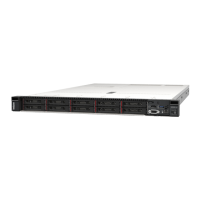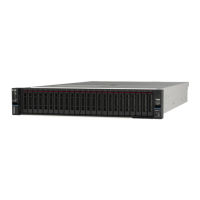Complete the following steps to enable SGX.
Step 1. Restart the system. Before the operating system starts up, press the key specified in the on-screen
instructions to enter the Setup Utility. (For more information, see the “Startup” section in the LXPM
documentation compatible with your server at
https://sysmgt.lenovofiles.com/help/topic/lxpm_
frontend/lxpm_product_page.html
.)
Step 2. Go to System settings ➙ Processors ➙ UMA-Based Clustering and disable the option.
Step 3. Go to System settings ➙ Processors ➙ Total Memory Encryption (TME) and enable the option.
Step 4. Save the changes, then go to System settings ➙ Processors ➙ SW Guard Extension (SGX) and
enable the option.
RAID configuration
Using a Redundant Array of Independent Disks (RAID) to store data remains one of the most common and
cost-efficient methods to increase server's storage performance, availability, and capacity.
RAID increases performance by allowing multiple drives to process I/O requests simultaneously. RAID can
also prevent data loss in case of a drive failure by reconstructing (or rebuilding) the missing data from the
failed drive using the data from the remaining drives.
RAID array (also known as RAID drive group) is a group of multiple physical drives that uses a certain
common method to distribute data across the drives. A virtual drive (also known as virtual disk or logical
drive) is a partition in the drive group that is made up of contiguous data segments on the drives. Virtual drive
is presented up to the host operating system as a physical disk that can be partitioned to create OS logical
drives or volumes.
An introduction to RAID is available at the following Lenovo Press website:
https://lenovopress.lenovo.com/lp0578-lenovo-raid-introduction
Detailed information about RAID management tools and resources is available at the following Lenovo Press
website:
https://lenovopress.lenovo.com/lp0579-lenovo-raid-management-tools-and-resources
Notes:
• Before setting up RAID for NVMe drives, follow the below steps to enable VROC:
1. Restart the system. Before the operating system starts up, press the key specified in the on-screen
instructions to enter the Setup Utility. (For more information, see the “Startup” section in the LXPM
documentation compatible with your server at
https://sysmgt.lenovofiles.com/help/topic/lxpm_frontend/
lxpm_product_page.html
.)
2. Go to System settings ➙ Devices and I/O Ports ➙ Intel VMD and enable the option.
3. Save the changes and reboot the system.
• VROC Intel-SSD-Only supports RAID levels 0, 1, 5, and 10 with Intel NVMe drives.
• VROC Premium requires an activation key and supports RAID levels 0, 1, 5, and 10 with non-Intel NVMe
drives. For more information about acquiring and installing the activation key, see
https://fod.lenovo.com/
lkms
.
Deploy the operating system
Several options are available to deploy an operating system on the server.
438
ThinkSystem SR630 V3 User Guide

